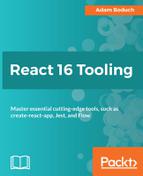In this chapter, you learned about Jest. You learned that the key driving principles of Jest are creating effective mocks, test isolation and parallel execution, and ease of use. You then learned that react-scripts makes running your unit tests even easier by providing some basic configuration to use with Jest.
When running Jest, you saw that watch mode is the default when running Jest via react-scripts. Watch mode is especially useful when you have lots of tests that don't need to run every time you make a source change—only relevant tests are executed.
Next, you performed some basic assertions in your unit tests. Then, you created a mock for the fs module and performed assertions on the mocked functions to ensure that they're being used as expected. You then evolved these tests to make use of the inherent asynchronous capabilities of Jest. Unit test coverage reporting is built into Jest, and you learned how to view this report by passing an additional argument.
In the next chapter, you'll learn how to create type-safe components using Flow.
